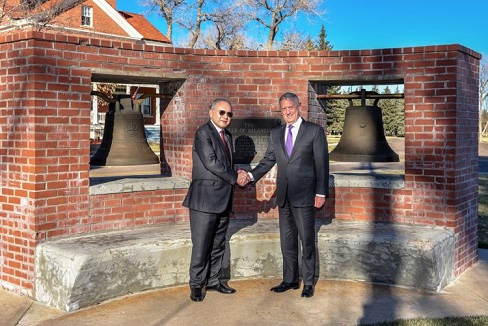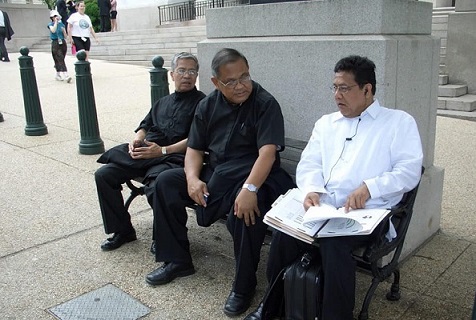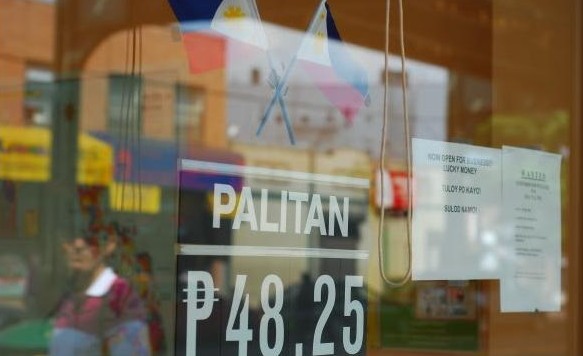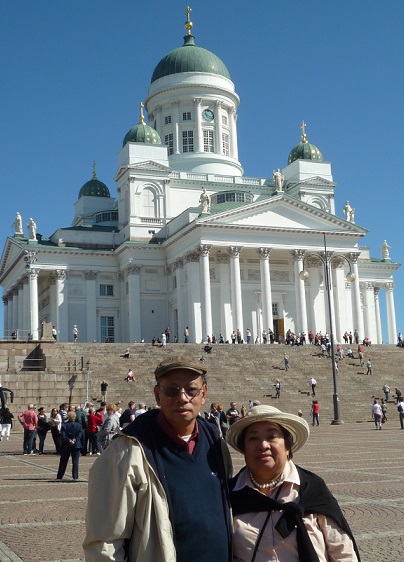PHL, U.S. defense chiefs made it happen; bells are back in Samar Part 2

Secretary of Defense James Mattis officially presented the bells to Philippine Ambassador Jose Manuel Romualdez. U.S. Air Force photo by Airman 1st Class Braydon Williams
Around this time, Jean Wall was invited to attend the next Wyoming Veterans Commissioners meeting. She presented newly discovered facts but refused to take sides. After her presentation to the WVC, Sestak made a motion for the return of the two church bells and put it to a vote. The motion won. Sestak did a 180-degree turn. I was ecstatic. I thought the return was going to happen soon.
Poisoned the tree
Not yet. Those who opposed to the return continued their campaign to keep the bells. Wall and Sestak were scheduled to meet with then-Wyoming Governor, Dave Freudenthal, shortly after the vote but that meeting was abruptly cancelled. The antis had poisoned the tree.
The years 2010 to 2012 were crucial. I formed the Balangiga Reconciliation Initiative (BRI) with Jim Flynn and John Dickson. We continued to lobby in Congress and some lawmakers who believed in our cause filed resolutions of support. We met with then-Ambassador Jose Cuisia and Delfin Lorenzana, who was at the time head of the Office of Veterans Affairs at the Philippine Embassy. I have known Secretary Lorenzana for many years because of the veterans issue. Lorenzana went on to become Defense Secretary under President Rodrigo Duterte. The bells brought us back together again last March 2018 in the office of Secretary Lorenzana in Manila.
Green light from Obama
In 2012, we learned that then-President Barack Obama had given the green light for the return of the bells. It would have been the highlight of former Philippine President Benigno ‘Noynoy’ Aquino’s state visit to Washington D.C. in November. The bells was among the top three topics in the agenda. There were so many people working on this matter in the State Department and the Pentagon helping to facilitate the return of the bells.

The author (in white shirt) with Bishop Leonardo Medroso of Borongan and Father Agustin Opalalic, a pastor at the Roman Catholic Diocese of San Diego, lobbied the U.S. Congress for the return of the bells in 2005. Photos courtesy of R Sonny Sampayan
Our group was reminded that the U.S. government could not spend a penny for the return. Our group, with support from unnamed members of the Filipino American community, began to receive pledges; we needed to raise funds quietly anticipating that the return was imminent. It may not happen before or after the Aquino visit but it was going to happen. We were both thrilled and challenged because the project was becoming more complicated — and expensive. At the time, we were working on a potential budget of anywhere from $250K to $500K for the cost of removing two bells from Wyoming, one bell from Korea, crating them, and shipping them to Samar. A major challenge was that we could not raise funds publicly because there had been no official word from the U.S. government. Still, our group was able to receive pledges of up to $70K from the FilAm community. But again, three Wyoming delegates got into the act. They introduced a rider to the NDAA or the National Defense Authorization Act which prevented the return of the church bells.
The language on the subsequent 2018 NDAA was the turning point because Congress gave the authority to Secretary of Defense James Mattis to return the bells if certain pre-conditions were met. By this time, several groups of people working independently of each other had been coordinating with top-level officials for the return. They had access to high-level officials of the U.S. government and funds available to pay for the required cost. We didn’t coordinate with them, they didn’t coordinate with us.
On November 14, Mattis announced the return of the Balangiga bells to the Philippines in a ceremony at Warren Air Force Base. I credit Mattis, Dr. Joseph Felter, who is his Deputy Assistant Secretary of Defense for Southeast Asia. I also credit Secretary Lorenzana and members of the U.S.-Philippines Society for the turn of events.
One month later, my wife Edith and I visited the tomb of Company C Commander Capt. Thomas Connell at West Point. The Roman Catholic faith is a forgiving institution. As a Special Envoy of the Diocese of Borongan, it is my duty to forgive those who were involved in the Balangiga incident.
© The FilAm 2018
Part 1: The bells of Balangiga: The politics and quiet diplomacy behind their long journey home












